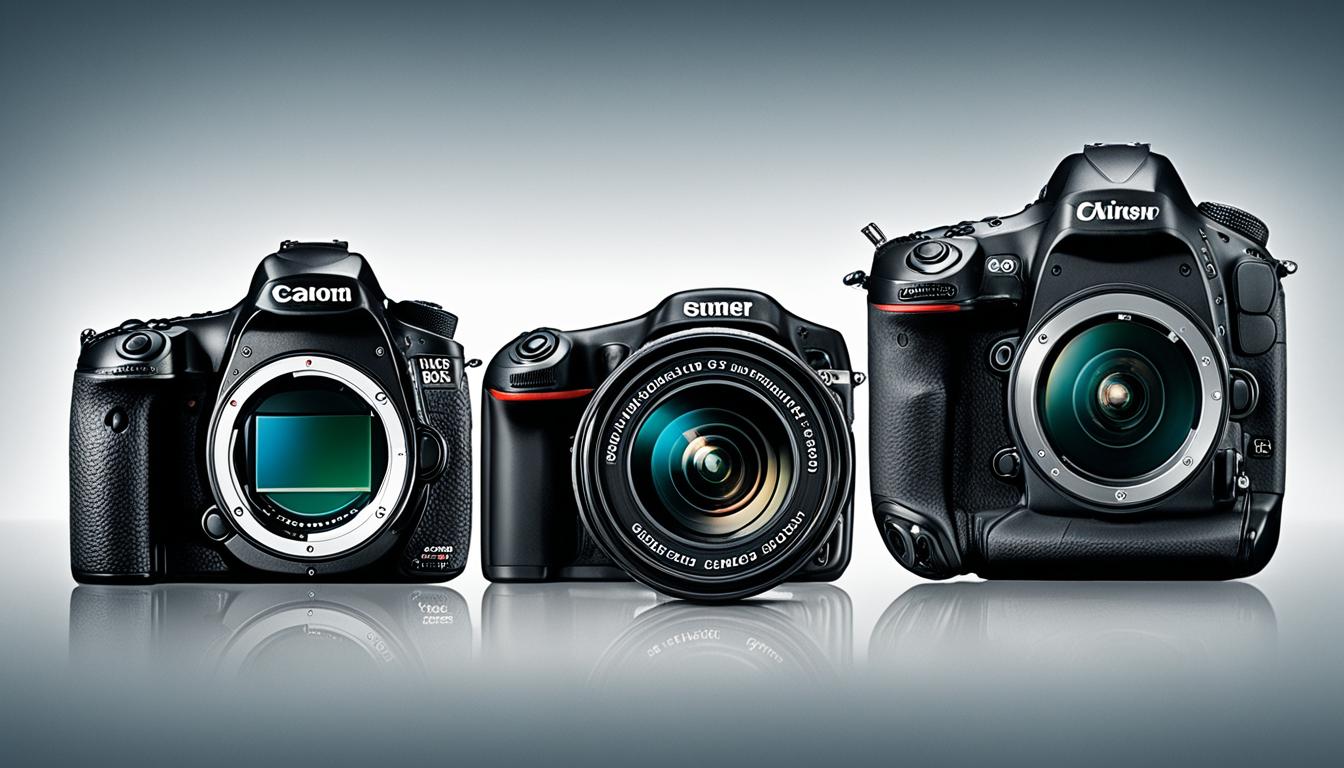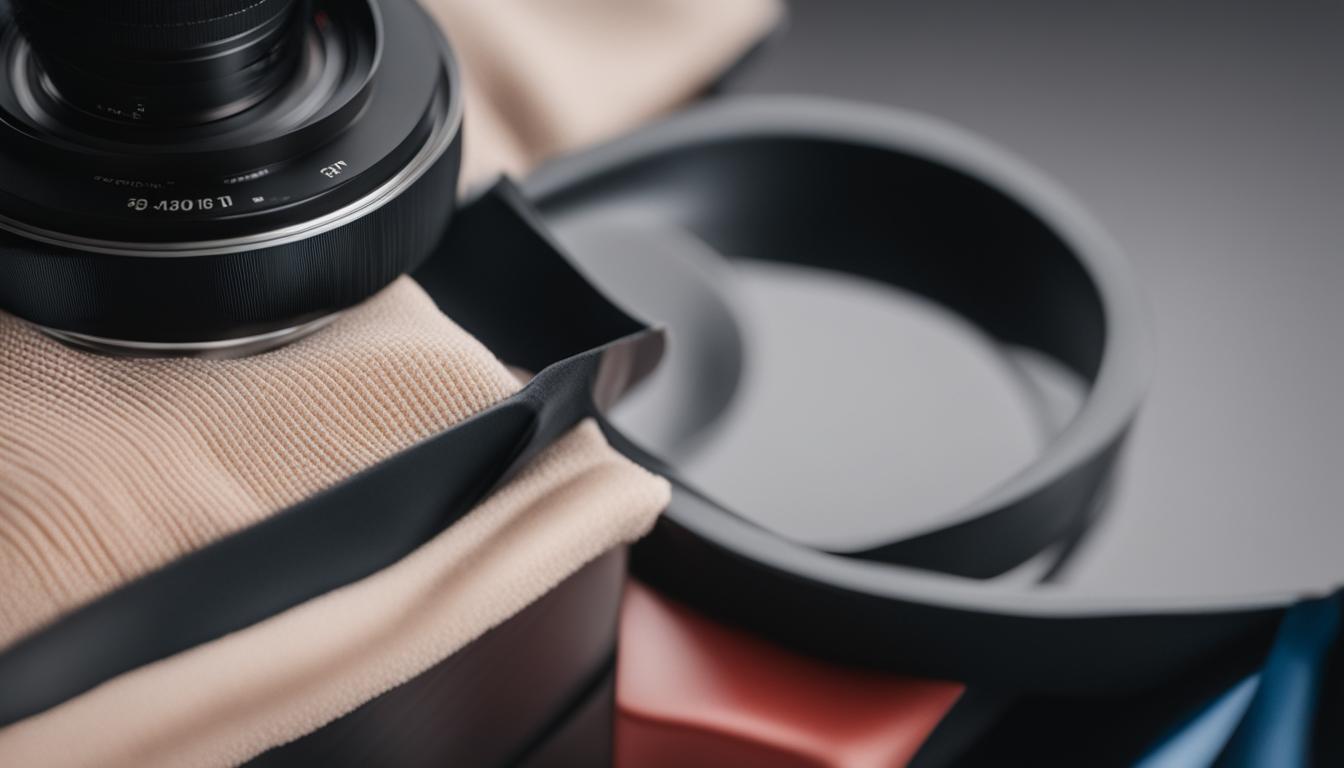Are you a beginner photographer struggling to decide on your first camera? We know how overwhelming it can be with the numerous options available in the market. That’s why we’re here to help! In this article, we’ll provide you with all the information you need to choose between a DSLR and a mirrorless camera, ensuring you make the best decision for your photography journey.
Key Takeaways:
- Consider your needs and preferences, such as size, weight, and portability, when choosing between a DSLR and a mirrorless camera.
- DSLR cameras are more affordable for beginners, offer a wide range of lenses, and have longer battery life.
- Mirrorless cameras are compact, lightweight, and provide excellent image quality.
- Both DSLRs and mirrorless cameras offer interchangeable lenses, enabling you to experiment with different effects.
- Ultimately, the best camera for beginners is the one that feels comfortable to use and helps you explore your passion for photography.
Understanding DSLR Cameras
When diving into the world of photography, it’s essential to understand the advantages of DSLR cameras. DSLR, short for digital single-lens reflex, is a type of camera that features a mirror and pentaprism system. This innovative design allows light to enter the camera and pass through a mirror which reflects it into an optical viewfinder. With a DSLR, you’ll see the image exactly as it appears through the lens in real-time, giving you a precise preview of your shot.
There are several benefits to choosing a DSLR camera for your journey as a beginner photographer. Let’s explore some of these advantages:
- High-Quality Images: DSLRs are renowned for their ability to capture high-resolution, sharp, and vibrant images. The larger image sensors in DSLR cameras enable them to capture more detail compared to compact cameras or smartphones.
- Wide Lens Selection: One of the key advantages of DSLRs is the vast selection of lenses available. Whether you’re interested in wide-angle landscapes, portrait photography, or telephoto shots, you’ll find a lens that suits your specific needs. This versatility allows you to explore different styles and techniques as you progress in your photography journey.
- Long Battery Life: DSLR cameras are known for their extended battery life, which ensures you can capture more shots without worrying about running out of power. This is especially beneficial when embarking on outdoor shoots or events that require extended shooting sessions.
- Affordability: DSLR cameras are often more affordable compared to their mirrorless counterparts, making them an excellent choice for beginners who want to invest in a camera without breaking the bank. With the wide range of affordable DSLR cameras available in the market, you can find a model that suits your budget.
As a beginner, DSLR cameras provide a solid foundation for learning essential photography techniques. With their high-quality images, versatile lens options, long battery life, and affordability, DSLRs empower you to explore your creativity and capture stunning photographs.
“With a DSLR, you’ll see the image exactly as it appears through the lens in real-time, giving you a precise preview of your shot.”
Exploring Mirrorless Cameras
Mirrorless cameras have revolutionized the world of photography with their innovative design and advanced features. Unlike DSLRs, mirrorless cameras do not have a mirror or pentaprism. Instead, they utilize electronic viewfinders or LCD screens to display the image in real-time. This unique design allows for a more compact and lightweight camera body, making mirrorless cameras a popular choice among professional photographers and beginners alike.
Despite their smaller size, mirrorless cameras offer image quality that is comparable to DSLRs. With advancements in technology, mirrorless cameras now boast high-resolution sensors, excellent low-light performance, and impressive dynamic range. This means you can capture stunning images with rich details and vibrant colors.
One of the key advantages of mirrorless cameras is their versatility. These cameras often come with a wide range of features that give you greater flexibility and control over your photography. With customizable shooting modes, advanced autofocus systems, and in-camera image stabilization, mirrorless cameras allow you to capture the perfect shot in any situation.
Additionally, mirrorless cameras offer a variety of lens options to suit your creative needs. You can choose from a growing selection of native lenses specifically designed for mirrorless camera systems, as well as adapt lenses from other brands using lens adapters. This wide range of lens choices allows you to explore different perspectives, focal lengths, and artistic styles.
“Mirrorless cameras have unlocked a new level of creativity for photographers. With their compact size, advanced features, and outstanding image quality, they are a game-changer in the world of photography.”
To give you a better understanding of the key differences between mirrorless cameras and DSLRs, let’s compare their image quality:
| Image Quality | Advantages | |
|---|---|---|
| DSLRs | High image quality | – Larger sensor size – Wide choice of lenses – Optical viewfinder for real-time composition |
| Mirrorless Cameras | Comparable image quality | – Compact and lightweight – Advanced features – Electronic viewfinder for real-time preview |
The table above shows that while DSLRs may have a slight advantage in terms of sensor size, mirrorless cameras offer a comparable image quality. The compact and lightweight nature of mirrorless cameras makes them ideal for travel and everyday photography. The advanced features, such as electronic viewfinders and in-camera shooting modes, provide a more intuitive and immersive shooting experience.
Ultimately, whether you choose a mirrorless camera or a DSLR depends on your specific needs and preferences. Both camera systems have their strengths and are capable of producing stunning images. Consider factors such as size, weight, versatility, and the range of available lenses when making your decision.
Now that we have explored mirrorless cameras, let’s dive deeper into the pros and cons of DSLR cameras for beginners in the next section.

Pros and Cons of DSLR Cameras for Beginners
When it comes to choosing a camera for beginners, DSLR cameras have several advantages worth considering. Let’s take a closer look at the pros and cons of DSLR cameras:
| Pros | Cons |
|---|---|
|
|
The Advantages of DSLR Cameras for Beginners
DSLR cameras offer several advantages that make them a great choice for novice photographers. One of the standout features of DSLRs is the reliable optical viewfinder, which allows you to see the scene through the lens in real-time. This viewfinder provides a clear and accurate representation of the image, making it easier to compose your shots.
In addition to the optical viewfinder, DSLR cameras offer a wide range of lens options. This allows you to experiment with different focal lengths and perspectives, giving you more creative control over your images. Whether you’re interested in landscape photography, portraiture, or wildlife photography, DSLRs provide the versatility to capture a wide variety of subjects with ease.
Another advantage of DSLR cameras is their intuitive controls. These cameras are designed to provide a user-friendly experience, allowing beginners to adjust settings and navigate menus with ease. With dedicated buttons and dials, you can quickly access essential functions like ISO, shutter speed, and aperture, ensuring you never miss a shot.
DSLR cameras also tend to have longer battery life compared to mirrorless cameras. This means you can shoot for extended periods without worrying about running out of power. Furthermore, DSLRs are generally more affordable, especially when considering entry-level models, making them an accessible option for beginners on a budget.
The Limitations of DSLR Cameras for Beginners
While DSLR cameras offer numerous advantages, they do come with a few limitations. One of the most significant drawbacks is their bulky and heavy design. DSLRs are larger and heavier compared to mirrorless cameras, which can be a challenge when carrying them around for extended periods or traveling. However, it’s worth noting that entry-level DSLRs have become increasingly compact and lightweight.
Another limitation of DSLR cameras is the potential lack of advanced features found in mirrorless models. Mirrorless cameras often incorporate cutting-edge technologies, such as in-body image stabilization and fast autofocus systems. While DSLRs can still produce high-quality images, they may lack some of the advanced features that cater to specific photography styles or professional needs.
Despite these limitations, DSLR cameras remain an excellent choice for beginners. Their combination of reliable optical viewfinders, wide lens options, intuitive controls, longer battery life, and affordability make them a solid foundation for learning photography techniques.
With all this in mind, let’s now turn our attention to mirrorless cameras and examine their own set of advantages and drawbacks in the next section.
Pros and Cons of Mirrorless Cameras for Beginners
Mirrorless cameras have gained popularity among professionals and photography enthusiasts due to their impressive features and compact design. As a beginner, it’s essential to weigh the pros and cons of mirrorless cameras before making a decision.
Here are the advantages of mirrorless cameras:
- Compact size: Mirrorless cameras are significantly smaller and lighter than DSLRs, making them ideal for on-the-go photography.
- Lightweight design: With their lightweight construction, mirrorless cameras are comfortable to handle, minimizing fatigue during long photography sessions.
- Excellent image quality: Despite their smaller size, mirrorless cameras deliver exceptional image quality, thanks to advanced sensor technology and image processors.
While mirrorless cameras offer numerous benefits, there are also a few drawbacks to consider:
- Shorter battery life: Mirrorless cameras tend to consume more power due to the continuous use of electronic viewfinders or LCD screens. As a result, their battery life may be shorter compared to DSLRs.
- Higher cost: Mirrorless cameras often come with a higher price tag, especially when considering the cost of lenses. However, entry-level models are becoming more affordable.
- Limited features in entry-level models: Some entry-level mirrorless cameras may lack certain advanced features or electronic viewfinders found in higher-end models.
Despite these limitations, mirrorless cameras showcase remarkable advancements in technology and provide an excellent option for beginners looking for a lightweight and versatile camera.
Let’s take a closer look at the image quality comparison between mirrorless cameras and DSLRs:
“Mirrorless cameras have come a long way in terms of image quality, rivaling DSLRs in many aspects. The advancements in sensor technology and image processors have allowed mirrorless cameras to capture stunning photos with excellent detail and dynamic range. While DSLRs still maintain their edge in certain areas, such as autofocus speed, the image quality difference between the two options is not significant, especially for beginners.”
Image Quality Comparison – Mirrorless Cameras vs. DSLRs
| Aspect | Mirrorless Cameras | DSLRs |
|---|---|---|
| Image Sensor | High-resolution sensors with excellent dynamic range | High-quality sensors with excellent dynamic range |
| Image Processing | Powerful processors for fast and accurate image rendering | Efficient processors for high-quality image processing |
| Autofocus | Advanced autofocus systems with reliable tracking | Fast and accurate autofocus systems with effective tracking |
| Low Light Performance | Due to their larger sensors, mirrorless cameras often excel in low light conditions | DSLRs offer excellent low light performance with larger sensors |
| Overall Image Quality | Mirrorless cameras deliver exceptional image quality, comparable to DSLRs | DSLRs produce high-quality images with excellent sharpness and detail |

As shown in the table above, both mirrorless cameras and DSLRs offer excellent image quality. The choice between the two ultimately depends on your specific requirements and preferences.
Key Factors to Consider When Choosing Between DSLR or Mirrorless for Beginners
When it comes to choosing your first camera, whether you’re just starting out or looking to upgrade, it can be overwhelming with the plethora of options available. Two popular choices for beginners are DSLR and mirrorless cameras. Each has its own strengths and considerations to keep in mind when making a decision. In this section, we’ll explore the key factors to consider when choosing between DSLR and mirrorless cameras.
Size, Weight, and Portability
One of the first factors to consider is the size, weight, and portability of the camera. Mirrorless cameras are known for their compact and lightweight design, making them easier to carry around for everyday shooting or travel. On the other hand, DSLR cameras tend to be bulkier and heavier due to their mirror and prism system. However, entry-level DSLRs have become more compact and lightweight in recent years, offering a good balance between portability and functionality.
Interchangeable Optics and Control over Depth of Field
Another important consideration is the availability of interchangeable optics and the control over depth of field. DSLR cameras have a wide variety of lenses to choose from, giving you versatility and creative control. With different lenses, you can capture a variety of subjects and achieve different effects, such as beautiful bokeh or a sharp focus on the subject. Mirrorless cameras also offer interchangeable lenses, although the selection may be more limited compared to DSLRs.
Budget
Your budget is an essential factor to consider when choosing a camera. DSLR cameras, especially entry-level models, tend to be more affordable compared to mirrorless cameras. The cost of lenses is also an important consideration as lenses can significantly add to the overall investment. Mirrorless cameras, while often pricier, offer advanced features and technology suitable for both beginners and professionals.
It’s important to note that both DSLR and mirrorless cameras have their own advantages and disadvantages. You should carefully consider your priorities, photography goals, and budget before making a decision. Here’s a summary of the key factors to consider:
| Factor | DSLR Cameras | Mirrorless Cameras |
|---|---|---|
| Size, Weight, and Portability | Bulky and heavy, but compact options available | Compact and lightweight, ideal for travel |
| Interchangeable Optics | Wide range of lenses available | Limited selection of lenses |
| Control over Depth of Field | Excellent depth of field control with various lenses | Depth of field control is available |
| Budget | More affordable, especially entry-level models | Tend to be pricier, but offer advanced features |
By carefully considering these factors, you can make an informed decision and choose the best camera for beginners that suits your needs, preferences, and budget. Remember, the right camera is the one that feels comfortable in your hands, empowers you to capture stunning images, and sparks your passion for photography. Now that we’ve explored the key factors to consider, let’s move on to the conclusion.
Size, Weight, and Portability
When it comes to beginner photography equipment, size, weight, and portability play a crucial role in determining the right camera. Mirrorless cameras have a distinct advantage in this area due to their design without a mirror and pentaprism. They are typically more compact and lighter compared to DSLRs, making them easier to carry and more suitable for travel.
Mirrorless cameras, such as the Sony Alpha a6000 and the Fujifilm X-T30, offer a perfect balance between functionality and portability. These cameras are designed to be lightweight, making them ideal for photographers on the go without compromising image quality or performance.
“Mirrorless cameras are a game-changer for photographers who value both quality and convenience. Investing in a mirrorless camera allows you to capture stunning shots while effortlessly carrying your camera wherever you go.”
However, it’s important to note that the gap between mirrorless and DSLR cameras in terms of size and weight has narrowed. Entry-level DSLRs, such as the Canon EOS Rebel T7i and the Nikon D5600, have become increasingly compact and lightweight. These affordable DSLR cameras offer beginner photographers a good balance between portability and functionality.
Ultimately, the decision between a mirrorless camera and a DSLR camera should be based on your individual photography needs. If you prioritize portability and ease of use, a mirrorless camera may be the perfect fit for you. On the other hand, if you’re seeking a camera that offers a diverse range of lenses and robust performance, a compact DSLR might be the way to go.
Interchangeable Optics and Control over Depth of Field
When it comes to capturing stunning and professional-looking photographs, having control over depth of field is key. This is where interchangeable optics play a crucial role in photography. Both DSLR and mirrorless cameras offer this feature, allowing beginners to experiment with different lenses and achieve the desired effects.
DSLR Cameras:
DSLRs are known for their wide variety of interchangeable optics, providing photographers with a vast range of lens options for different shooting scenarios. Whether you want to capture landscapes in stunning detail, zoom in on distant subjects, or take close-up shots with a macro lens, DSLRs have you covered. The ability to switch lenses gives you the creative freedom to control the depth of field and make your subject stand out from the background.
Mirrorless Cameras:
Mirrorless cameras also offer interchangeable optics, although the selection may be more limited compared to DSLRs. However, don’t let that discourage you! Mirrorless cameras still provide a good range of lenses to choose from, allowing you to explore your creativity and achieve impressive results.
Whether you opt for a DSLR or a mirrorless camera, the ability to switch lenses opens up a world of possibilities for beginners. You can experiment with different focal lengths, apertures, and lens types to capture unique perspectives and create stunning images.
| Camera Type | Interchangeable Optics | Lens Options | Control over Depth of Field |
|---|---|---|---|
| DSLR | ✅ | Wide variety | Excellent |
| Mirrorless | ✅ | Good range | Effective |
Conclusion
Choosing your first camera can be an exciting yet overwhelming decision. Both DSLR and mirrorless cameras have their unique advantages and disadvantages, making it essential to consider your preferences and needs. Factors such as size, weight, portability, interchangeable optics, and control over depth of field should be taken into account.
Thorough research is key to finding the best camera for beginners. Take the time to explore different models, read reviews, and even try them out in person if possible. Consider the long-term investment in lenses and accessories, as your camera system will grow with your skills and interests.
Ultimately, the perfect camera for you is the one that feels comfortable to use and helps you delve into your passion for photography. Whether you choose a DSLR or mirrorless camera, remember that the journey is just beginning, and the most important aspect is to enjoy capturing precious moments.
FAQ
What is a DSLR camera?
A DSLR camera, or digital single-lens reflex camera, is equipped with a mirror and pentaprism system that reflects light into an optical viewfinder, allowing users to see the image through the lens in real-time.
What is a mirrorless camera?
A mirrorless camera is a newer type of camera that does not have a mirror or pentaprism. Instead, it relies on electronic viewfinders or LCD screens to display the image in real-time.
What are the advantages of DSLR cameras for beginners?
DSLR cameras offer a reliable optical viewfinder, a wide range of lens options, intuitive controls, and longer battery life. They are also generally more affordable compared to mirrorless cameras.
What are the advantages of mirrorless cameras for beginners?
Mirrorless cameras are compact, lightweight, and offer excellent image quality. They are popular among professionals and photographers who prioritize portability. They also have advanced features and interchangeable optics.
What factors should beginners consider when choosing between DSLR and mirrorless cameras?
Beginners should consider factors such as size, weight, portability, interchangeable optics, control over depth of field, and budget when choosing between DSLR and mirrorless cameras.
Is Camera Maintenance Different for DSLR and Mirrorless Cameras?
When it comes to camera gear maintenance tips, there are some differences between DSLR and mirrorless cameras. For DSLRs, it’s important to regularly clean the mirror and sensor, while for mirrorless cameras, attention should be given to the electronic viewfinder and the sensor. Both types require regular lens cleaning and proper storage.




